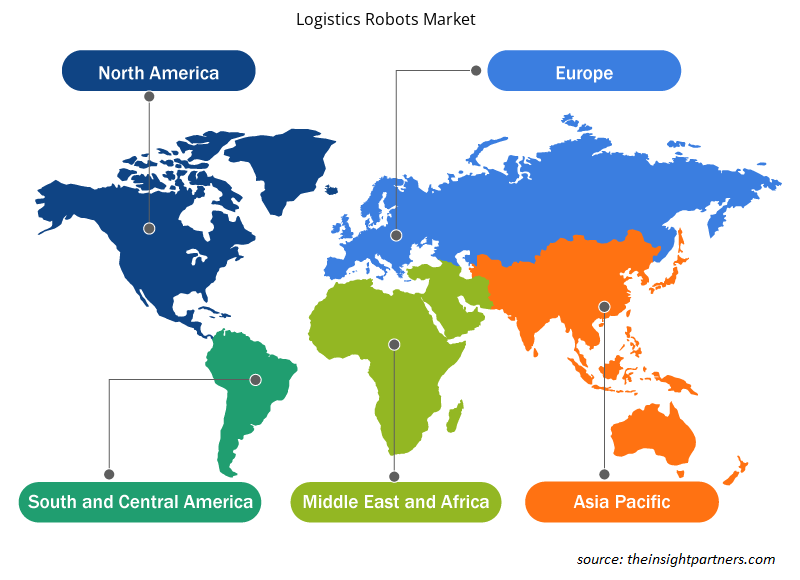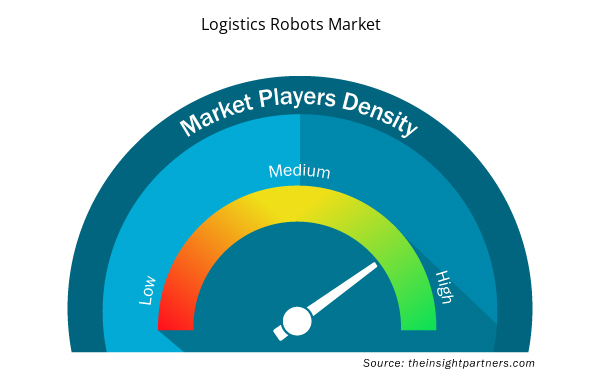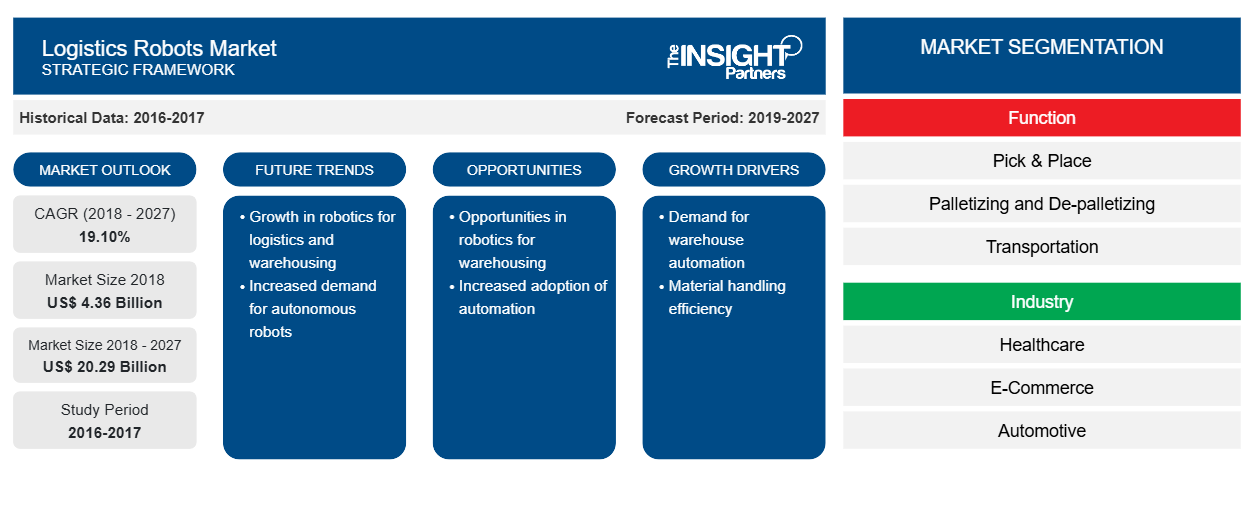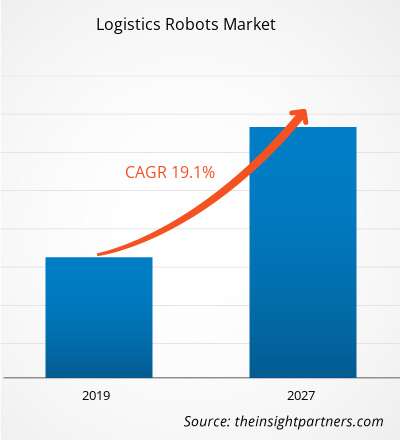Nel 2018 il mercato dei robot logistici è stato valutato 4.356,2 milioni di dollari USA e si prevede che crescerà a un CAGR del 19,10% dal 2019 al 2027, raggiungendo i 20.293,4 milioni di dollari USA entro il 2027.
L'aumento del numero di aziende di logistica e magazzinaggio che si stanno concentrando in modo deciso sull'incorporazione di robot per ottenere i vantaggi di una maggiore efficienza, velocità e profitti aumentati per rimanere competitivi in un mercato. L'adozione di tecnologie avanzate come le tecnologie di magazzinaggio e logistica robotizzate sta crescendo per migliorare l'efficienza operativa a prezzi accessibili. Il mercato globale dei robot per la logistica è guidato da fattori come una percentuale crescente di popolazione anziana a livello globale che porta alla carenza di manodopera e all'aumento delle reti della catena di fornitura a livello globale, ma si prevede che un elevato investimento di capitale per l'implementazione di robot per la logistica limiterà la crescita del mercato dei robot per la logistica durante il periodo di previsione. Tuttavia, l'aumento dell'automazione dei magazzini e il mercato consolidato nei paesi APAC ed europei probabilmente offriranno sostanziali opportunità di crescita per migliorare la quota di mercato per gli operatori del settore nel prossimo futuro.
Approfondimenti di mercato
La crescente percentuale di popolazione anziana a livello globale porta alla carenza di manodopera
La crescente percentuale di popolazione anziana in tutto il mondo è uno dei principali fattori per la riduzione della manodopera in vari settori. Ogni paese nel mondo sta assistendo a un aumento del numero di anziani nella propria comunità. L'invecchiamento della popolazione è diventato uno dei fattori sostanziali per le trasformazioni sociali nel 21° secolo in tutti i settori, che abbracciano il lavoro e i mercati finanziari. Tuttavia, vari paesi come l'Italia, il Giappone e molti altri sono i paesi che hanno elencato il numero massimo di proporzioni di popolazione anziana, considerando una percentuale sostanziale della loro popolazione di età superiore ai 65 anni. Secondo l'OMS, si prevede che circa 2 milioni di persone in tutto il mondo avranno più di 60 anni entro il 2050, il che rappresenta il triplo di quanto fosse nel 2000. L'aumento del numero di popolazione anziana ha rappresentato la carenza di manodopera. L'implementazione di robot logistici in diversi settori svolge un ruolo importante, poiché riduce il costo complessivo del processo, aumentando la produttività, migliorando la sicurezza e riducendo l'errore umano. I rapidi progressi tecnologici nei magazzini a livello globale si stanno concentrando sui requisiti correlati alle difficoltà affrontate dal processo della supply chain e assicurano che la tecnologia utilizzata sia associata agli obiettivi aziendali. L'implementazione di robot in diverse unità, funzioni e fasi nei cicli di vita dei prodotti è stata una sfida fondamentale affrontata dai magazzini oggi nel loro percorso di crescita, che, a sua volta, stimolerebbe il mercato dei robot logistici nel prossimo futuro.
Personalizza questo report in base alle tue esigenze
Riceverai la personalizzazione gratuita di qualsiasi report, comprese parti di questo report, o analisi a livello nazionale, pacchetto dati Excel, oltre a usufruire di grandi offerte e sconti per start-up e università
- Scopri le principali tendenze di mercato in questo rapporto.Questo campione GRATUITO includerà analisi di dati che spaziano dalle tendenze di mercato alle stime e alle previsioni.
Informazioni sul tipo di robot
Il segmento dei robot mobili collaborativi ha conquistato la quota maggiore nel mercato globale dei robot per la logistica. Vengono impiegati in vari settori per svolgere una serie di attività come imballaggio, assistenza macchine e movimentazione materiali, poiché questi cobot sono sufficientemente competenti da gestire sia operazioni pesanti che leggere. Sono altamente accurati, flessibili e precisi. Inoltre, i cobot sono facili da manutenere e sono più accessibili per la riconfigurazione e la riprogrammazione. Questi robot possono anche gestire lavori delicati; inoltre, si adattano in base alle incongruenze che si verificano durante i processi di produzione. I cobot sono in grado di raccogliere metriche critiche per fornire analisi di bordo, insieme a report, per semplificare il processo decisionale che guida il mercato complessivo dei robot per la logistica.
Approfondimenti sulle funzioni
Il segmento dei trasporti ha conquistato la quota maggiore nel mercato globale dei robot logistici. Le merci sono pallettizzate e c'è una leggera variazione in diverse forme e dimensioni dei prodotti, che ha richiesto l'automazione per il carico e lo scarico di queste merci. La visione laser 3D è integrata con il nuovo software robotico, che aiuta gli utenti con una visibilità di diversi prodotti nei contenitori, determina la sequenza ideale di carico/scarico ed esegue il processo con un'elevata precisione. La robotica logistica è impiegata per spostare il rack di destinazione, disegnare e sollevare il cestello, allungare la forcella sullo scaffale e riportare la posizione di destinazione guida il mercato complessivo dei robot logistici.
Approfondimenti del settore
Il segmento della logistica esternalizzata ha catturato la quota maggiore nel mercato globale dei robot logistici. Questi fornitori di servizi logistici offrono vari servizi, tra cui magazzinaggio, gestione dell'inventario, trasporto, distribuzione, evasione degli ordini e consolidamento del trasporto merci. La domanda sempre crescente di gestione delle consegne tempestive e riduzione dei costi di spedizione, migliorando l'attenzione sul mantenimento del registro del materiale in magazzino e il core business e la riduzione delle attività aziendali che si prevede guideranno il mercato dei robot logistici durante il periodo di previsione.
Diverse strategie di iniziative di mercato sono comunemente adottate dalle aziende per espandere la propria presenza in tutto il mondo e soddisfare la crescente domanda. Questa strategia è osservata principalmente in Europa e APAC. I player presenti nel mercato dei robot logistici adottano la strategia di espansione e investimento in ricerca e sviluppo per ampliare la base clienti in tutto il mondo, il che consente anche ai player di mantenere il proprio marchio a livello globale.
Approfondimenti regionali sul mercato dei robot logistici
Le tendenze regionali e i fattori che influenzano il mercato dei robot logistici durante il periodo di previsione sono stati ampiamente spiegati dagli analisti di Insight Partners. Questa sezione discute anche i segmenti e la geografia del mercato dei robot logistici in Nord America, Europa, Asia Pacifico, Medio Oriente e Africa e Sud e Centro America.

- Ottieni i dati specifici regionali per il mercato dei robot logistici
Ambito del rapporto di mercato sui robot logistici
| Attributo del report | Dettagli |
|---|---|
| Dimensioni del mercato nel 2018 | 4,36 miliardi di dollari USA |
| Dimensioni del mercato entro il 2027 | 20,29 miliardi di dollari USA |
| CAGR globale (2018 - 2027) | 19,10% |
| Dati storici | 2016-2017 |
| Periodo di previsione | 2019-2027 |
| Segmenti coperti | Per funzione
|
| Regioni e Paesi coperti | America del Nord
|
| Leader di mercato e profili aziendali chiave |
|
Densità degli attori del mercato: comprendere il suo impatto sulle dinamiche aziendali
Il mercato dei robot logistici sta crescendo rapidamente, spinto dalla crescente domanda degli utenti finali dovuta a fattori quali l'evoluzione delle preferenze dei consumatori, i progressi tecnologici e una maggiore consapevolezza dei vantaggi del prodotto. Con l'aumento della domanda, le aziende stanno ampliando le loro offerte, innovando per soddisfare le esigenze dei consumatori e capitalizzando sulle tendenze emergenti, il che alimenta ulteriormente la crescita del mercato.
La densità degli operatori di mercato si riferisce alla distribuzione di aziende o società che operano in un particolare mercato o settore. Indica quanti concorrenti (operatori di mercato) sono presenti in un dato spazio di mercato in relazione alle sue dimensioni o al valore di mercato totale.
Le principali aziende che operano nel mercato dei robot logistici sono:
- AGV Internazionale
- Robotica Clearpath
- Società anonima Daifuku Co. Ltd.
- Società Fanuc
- Recupera Robotica Inc
Disclaimer : le aziende elencate sopra non sono classificate secondo un ordine particolare.

- Ottieni una panoramica dei principali attori del mercato dei robot logistici
Mercato dei robot logistici – Per tipo di robot
- Braccio robotico
- Veicolo a guida automatica
- Robot mobili collaborativi
- Altri
Mercato dei robot logistici – Per funzione
- Scegli e posiziona
- Pallettizzazione e depallettizzazione
- Trasporti
- Confezione
Mercato dei robot logistici – Per settore
- Assistenza sanitaria
- Commercio elettronico
- Automobilistico
- Esternalizzare la logistica
- Vedere al dettaglio
- Beni di consumo
- Cibo e bevande
- Altri
Mercato dei robot logistici – Per area geografica
America del Nord
- NOI
- Canada
- Messico
Europa
- Francia
- Germania
- Italia
- Regno Unito
- Russia
- Resto d'Europa
Asia Pacifico
- Cina
- India
- Corea del Sud
- Giappone
- Australia
- Resto dell'Asia Pacifica
Medio Oriente e Africa
- Sudafrica
- Arabia Saudita
- Emirati Arabi Uniti
- Resto del Medio Oriente e Africa
Sud America
- Brasile
- Argentina
- Resto del Sud America
Profili aziendali
- AGV Internazionale
- Robotica Clearpath
- Società anonima Daifuku Co. Ltd.
- Società Fanuc
- Azienda: Fetch Robotics Inc.
- Gruppo Kion AG
- KNAPP AG
- Colmorgen
- KUKA AG
- Società Toshiba
- Analisi storica (2 anni), anno base, previsione (7 anni) con CAGR
- Analisi PEST e SWOT
- Valore/volume delle dimensioni del mercato - Globale, regionale, nazionale
- Industria e panorama competitivo
- Set di dati Excel



Report Coverage
Revenue forecast, Company Analysis, Industry landscape, Growth factors, and Trends

Segment Covered
This text is related
to segments covered.

Regional Scope
North America, Europe, Asia Pacific, Middle East & Africa, South & Central America

Country Scope
This text is related
to country scope.
Domande frequenti
Automated guided vehicles (AGVs) are used for consistent as well as predicted transport of materials. AGVs might be serviced through conveyors, forklift trucks, or manual cart transport systems. The transport of bulk materials using AGVs helps minimize efforts required in repetitive transportation of small chunks of materials, with less human intervention. Apart from distribution and manufacturing, AGVs have also become an integral part of other industries, including retail, military, food & beverages, automotive, and healthcare. The deployment of AGVs benefits businesses by reducing the cost of labor required in manual execution of tasks; enhancing safety, accuracy, and productivity of products; and improving the efficiency of work when integrated with the warehouse management/control systems. Improved work efficiencies further helps streamline other processes, such as materials ordering and inventory management.
With the increasing importance of equipment in logistic markets in APAC, especially China and India, robot manufacturers realize that electronics innovations can complement production innovations in gaining a competitive advantage. Japan is a well-developed economy and is one of the most technologically advanced economies across the world. Also, the region has a few significant manufacturers of robots and factory automation systems such as Fanuc, Mitsubishi Electric, and Omron Corp, among others. The Japanese companies widely use automation solutions to maintain their competitive position in the market.
The continuous growth in consumer expectations is likely to drive continued investment for the adoption of logistics robots for performing operational functions in warehouses. Leveraging the modern supply chain technology as well as the Internet of Things (IoT), the focus on the “smart warehouse†concept is growing, which can serve as a hub to enhance the efficiency and speed of the entire supply chain process. The warehouse automation includes wearable wore by workers to sensors, logistics robots, internet-enabled devices, and smart equipment, which profoundly modify the logistics management. Warehouse management is constantly facing more pressures related to supply chain transformation, commoditization, and rising customer expectations. Therefore, the warehouse automation concept is an effective way to enhance efficiencies, reduce operational costs, and scale operations. The warehouse automation performs various activities such as data collection and inventory control, with million-dollar of investments.
Trends and growth analysis reports related to Electronics and Semiconductor : READ MORE..
The List of Companies - Logistics Robots Market
- AGV International
- Clearpath Robotics
- Daifuku Co. Ltd.
- Fanuc Corporation
- Fetch Robotics Inc
- KION GROUP AG
- KNAPP AG
- Kollmorgen
- Kuka AG
- Toshiba Corporation
The Insight Partners performs research in 4 major stages: Data Collection & Secondary Research, Primary Research, Data Analysis and Data Triangulation & Final Review.
- Data Collection and Secondary Research:
As a market research and consulting firm operating from a decade, we have published and advised several client across the globe. First step for any study will start with an assessment of currently available data and insights from existing reports. Further, historical and current market information is collected from Investor Presentations, Annual Reports, SEC Filings, etc., and other information related to company’s performance and market positioning are gathered from Paid Databases (Factiva, Hoovers, and Reuters) and various other publications available in public domain.
Several associations trade associates, technical forums, institutes, societies and organization are accessed to gain technical as well as market related insights through their publications such as research papers, blogs and press releases related to the studies are referred to get cues about the market. Further, white papers, journals, magazines, and other news articles published in last 3 years are scrutinized and analyzed to understand the current market trends.
- Primary Research:
The primarily interview analysis comprise of data obtained from industry participants interview and answers to survey questions gathered by in-house primary team.
For primary research, interviews are conducted with industry experts/CEOs/Marketing Managers/VPs/Subject Matter Experts from both demand and supply side to get a 360-degree view of the market. The primary team conducts several interviews based on the complexity of the markets to understand the various market trends and dynamics which makes research more credible and precise.
A typical research interview fulfils the following functions:
- Provides first-hand information on the market size, market trends, growth trends, competitive landscape, and outlook
- Validates and strengthens in-house secondary research findings
- Develops the analysis team’s expertise and market understanding
Primary research involves email interactions and telephone interviews for each market, category, segment, and sub-segment across geographies. The participants who typically take part in such a process include, but are not limited to:
- Industry participants: VPs, business development managers, market intelligence managers and national sales managers
- Outside experts: Valuation experts, research analysts and key opinion leaders specializing in the electronics and semiconductor industry.
Below is the breakup of our primary respondents by company, designation, and region:

Once we receive the confirmation from primary research sources or primary respondents, we finalize the base year market estimation and forecast the data as per the macroeconomic and microeconomic factors assessed during data collection.
- Data Analysis:
Once data is validated through both secondary as well as primary respondents, we finalize the market estimations by hypothesis formulation and factor analysis at regional and country level.
- Macro-Economic Factor Analysis:
We analyse macroeconomic indicators such the gross domestic product (GDP), increase in the demand for goods and services across industries, technological advancement, regional economic growth, governmental policies, the influence of COVID-19, PEST analysis, and other aspects. This analysis aids in setting benchmarks for various nations/regions and approximating market splits. Additionally, the general trend of the aforementioned components aid in determining the market's development possibilities.
- Country Level Data:
Various factors that are especially aligned to the country are taken into account to determine the market size for a certain area and country, including the presence of vendors, such as headquarters and offices, the country's GDP, demand patterns, and industry growth. To comprehend the market dynamics for the nation, a number of growth variables, inhibitors, application areas, and current market trends are researched. The aforementioned elements aid in determining the country's overall market's growth potential.
- Company Profile:
The “Table of Contents” is formulated by listing and analyzing more than 25 - 30 companies operating in the market ecosystem across geographies. However, we profile only 10 companies as a standard practice in our syndicate reports. These 10 companies comprise leading, emerging, and regional players. Nonetheless, our analysis is not restricted to the 10 listed companies, we also analyze other companies present in the market to develop a holistic view and understand the prevailing trends. The “Company Profiles” section in the report covers key facts, business description, products & services, financial information, SWOT analysis, and key developments. The financial information presented is extracted from the annual reports and official documents of the publicly listed companies. Upon collecting the information for the sections of respective companies, we verify them via various primary sources and then compile the data in respective company profiles. The company level information helps us in deriving the base number as well as in forecasting the market size.
- Developing Base Number:
Aggregation of sales statistics (2020-2022) and macro-economic factor, and other secondary and primary research insights are utilized to arrive at base number and related market shares for 2022. The data gaps are identified in this step and relevant market data is analyzed, collected from paid primary interviews or databases. On finalizing the base year market size, forecasts are developed on the basis of macro-economic, industry and market growth factors and company level analysis.
- Data Triangulation and Final Review:
The market findings and base year market size calculations are validated from supply as well as demand side. Demand side validations are based on macro-economic factor analysis and benchmarks for respective regions and countries. In case of supply side validations, revenues of major companies are estimated (in case not available) based on industry benchmark, approximate number of employees, product portfolio, and primary interviews revenues are gathered. Further revenue from target product/service segment is assessed to avoid overshooting of market statistics. In case of heavy deviations between supply and demand side values, all thes steps are repeated to achieve synchronization.
We follow an iterative model, wherein we share our research findings with Subject Matter Experts (SME’s) and Key Opinion Leaders (KOLs) until consensus view of the market is not formulated – this model negates any drastic deviation in the opinions of experts. Only validated and universally acceptable research findings are quoted in our reports.
We have important check points that we use to validate our research findings – which we call – data triangulation, where we validate the information, we generate from secondary sources with primary interviews and then we re-validate with our internal data bases and Subject matter experts. This comprehensive model enables us to deliver high quality, reliable data in shortest possible time.


 Ottieni un campione gratuito per questo repot
Ottieni un campione gratuito per questo repot